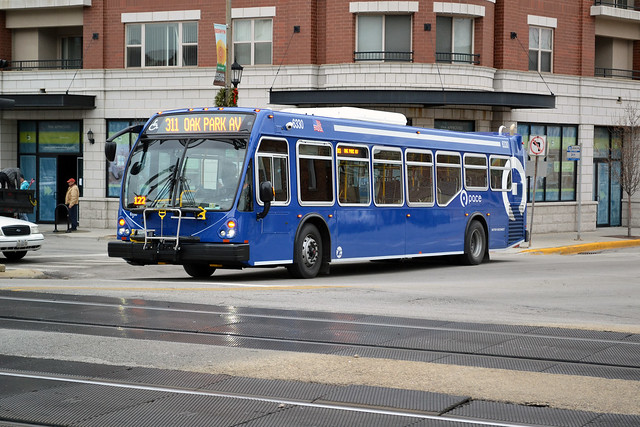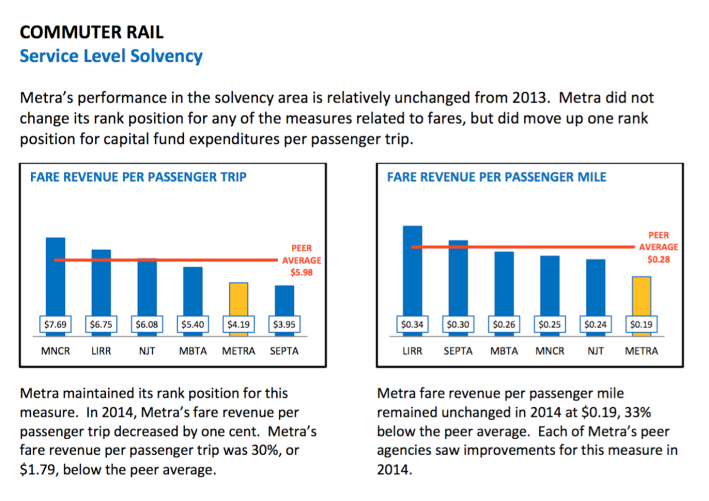
The Regional Transportation Authority's newest report, issued last week, compares the Chicago Transit Authority, Metra, and Pace, to their respective peers around the country. The report found that the CTA is efficient, relative to rapid transit systems in Atlanta, New York City, Philadelphia, Boston, and Washington, D.C.
The RTA also compared Metra, using 2014 performance figures, to New Jersey Transit, commuter rail in Philadelphia, commuter rail in Boston, and the Long Island Railroad and Metro North Railroad in greater New York City. RTA spokesperson Susan Massel said they excluded BART in San Francisco because it's not in the top 10 largest metropolitan areas and "for each mode we chose only 5 peers, so we picked the five that were most comparable."
Like the CTA's 'L' system, Metra also ran an efficient service compared to its peers. The commuter rail agency ranked first or second in three operating costs metrics. Metra, however, spent a larger portion of its budget on vehicle operations than the average of the five others, and spends slightly less than average on maintenance.
Metra didn't fare well on having good maintenance. It ranks fifth for having young vehicles in its fleet, and ranked fourth and below average for the average number of miles a vehicle traveled before breaking down. The RTA mentioned that Metra has finished bringing in new cars on the Metra Electric district line and has a plan to purchase new cars – instead of buying rider-friendly trains, they're locking in an old design another 30 years – for its other lines. The breakdown rate was high in 2014, the report said, because of the polar vortex issues that shut down lines on a couple days in January.
Metra managed to rank worse on service level solvency. They collect far less in ticket revenue per passenger than their peers, suggesting that Metra is undercharging. Since 2014, Metra's new administration – including a new board, board chair, and CEO – announced that fares would go up in 2015 and that they would raise fares on an annual basis.
Metra also competes with personal vehicles. Driving into downtown Chicago is cheaper than driving into Manhattan because there are no tolls within 20 miles of the Loop, and parking is relatively affordable. Low fares are good for riders, and may be commensurate with transit's lower mode share here than in the East Coast cities, but they may also signal that growth in demand for transit in the Chicago region is slow or non-existent.
It's better for riders and for the administration when fares are raised on a slow-but-steady basis, as opposed to significant increases every now and then. This allows Metra to better predict how much revenue it will raise and use that to strategize and plan for the long term, something they haven't done in a while. This change also gave them the confidence to sell debt, for the first time, to help pay for those new (but old-fashioned) train cars.

The Regional Transportation Authority also reviewed the performance of Pace suburban bus. They also liked at Pace's vanpool and paratransit for seniors and people with disabilities, but those aren't discussed here. Pace's suburban bus operations seemed to largely mirror Metra's commuter rail performance: they're successful at keeping operating costs down, but they spend, on average, a larger portion of their budget on vehicle operations than their peers, and a smaller portion on maintenance.
Additionally, Pace's fleet had a middle-of-the-road average vehicle age and a reasonably good average distance between bus breakdowns, relative to similar services in Orange County, California; Detroit; San Mateo County, California; New Yorks Nassau Inter-County Express; and San Francisco.
Again, like Metra, Pace's suburban bus operations collects much less in ticket revenue per passenger than its peers. The RTA partly blames the free rides program, saying one in six trips is a free ride.
Comparing ridership, Pace ranks low because it has a larger geographic coverage area, serving the lowest population density area among its five peers. The report said, "lower population densities require Pace to operate approximately twice as much service to achieve similar ridership levels as the top performer" on the two ridership metrics. That's on top of a 3.1 percent ridership decrease from 2013 to 2014, "following three years of consecutive growth."
The report doesn't discuss what kinds of population growth or declines each transit agency's service area – here and in the peer cities – saw. Nor do they look into the land use changes or policies that affect each region's potential to, ultimately, grow transit ridership. Other organizations have found that the Chicago region is still developing outside of the built up area, growing at a slower rate, and growing away from existing transit lines, all affecting transit usage and agency efficiencies.
These additions would give the metrics a stronger context, and help us assess whether the policies of the RTA, its three transit agencies, and state funding – or the lack thereof – are successful in growing ridership.
![]()
Did you appreciate this post? Streetsblog Chicago is currently funded until April 2016. Consider making a donation through our PublicGood site to help ensure we can continue to publish next year.




